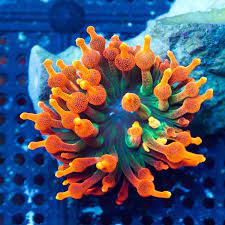Get ready to dive into the captivating world of the Colorado Sunburst Anemone (Actinodendron arboreum)! This magnificent sea creature, native to the western coast of North America, is a true spectacle of color and beauty. This anemone will leave you in awe with its large size, reaching up to 12 inches in diameter, and a stunning array of hues, including pink, purple, yellow, and orange.
A Closer Look at the Colorado Sunburst Anemone
The Colorado Sunburst Anemone boasts a distinctive physical appearance that sets it apart from other marine creatures. Its bulbous body and thick, fleshy column create a striking presence in any aquarium. The anemone’s long and slender tentacles, which can extend up to 8 inches, add an elegant touch to its overall appearance.
In its natural habitat, the Colorado Sunburst Anemone can be found in shallow, sandy areas within the intertidal zone. It prefers to cling to rocks and coral, showcasing its vibrant colors against the backdrop of the ocean floor.
Providing Optimal Care for the Colorado Sunburst Anemone
To ensure the well-being of your Colorado Sunburst Anemone, it is crucial to meet its specific care requirements. This anemone thrives in a spacious tank, ideally with at least 50 gallons of capacity. A sand substrate and ample live rock will provide a suitable environment for it to attach and anchor itself.
Maintaining stable water parameters is essential for the Colorado Sunburst Anemone’s health. Aim for a pH level between 8.2 and 8.4, a temperature ranging from 72 to 78°F, and a salinity level of 1.023 to 1.025. Regular monitoring and adjustments will help create an optimal habitat for this captivating creature.
Unleashing the Benefits of the Colorado Sunburst Anemone
Beyond its visual appeal, the Colorado Sunburst Anemone offers several benefits for your aquarium. Its vibrant colors inject life and excitement into your tank, creating a visually stunning centerpiece. As a natural cleaner, this anemone feeds on uneaten food and detritus, contributing to the overall cleanliness of your aquarium.
Navigating Potential Challenges
While the Colorado Sunburst Anemone is undoubtedly a stunning addition to any tank, it does come with a few challenges.
Its powerful sting requires careful consideration when selecting tankmates, as it can harm other fish and invertebrates.
Additionally, this anemone can display aggressive behavior and attempt to dominate the tank. Providing ample space and monitoring its interactions with other inhabitants will help maintain a harmonious aquatic environment.
In Conclusion
The Colorado Sunburst Anemone is a mesmerizing creature that can transform your aquarium into a vibrant underwater paradise. This anemone is a true gem with its captivating colors, unique physical characteristics, and natural cleaning abilities.
However, it is crucial to meet its specific care requirements and be mindful of its potential aggression. With proper care and attention, the Colorado Sunburst Anemone will reward you with stunning beauty and vitality in your aquatic world.
So, dive in and let the captivating allure of this anemone take your tank to new depths of excitement!
Frequently Asked Questions (FAQ)
Can I keep the Colorado Sunburst Anemone in a smaller tank?
While it is possible to keep the Colorado Sunburst Anemone in a smaller tank, it is not recommended. These anemones require ample space to thrive and should ideally be housed in a tank with at least 50 gallons of capacity.
How often should I feed my Colorado Sunburst Anemone?
The Colorado Sunburst Anemone is a predatory creature that primarily feeds on small fish, shrimp, and other meaty foods. Feeding them two to three times a week is recommended, ensuring that the food is small enough for the anemone to consume.
Can I keep multiple Colorado Sunburst Anemones in the same tank?
Keeping multiple Colorado Sunburst Anemones in the same tank is generally not advisable. These anemones can exhibit aggressive behavior towards one another, leading to territorial disputes. It is best to provide each anemone space to avoid potential conflicts.
How do I acclimate a Colorado Sunburst Anemone to my tank?
Proper acclimation is crucial to ensure the well-being of your Colorado Sunburst Anemone. Start by slowly dripping, acclimating the anemone to match the temperature and salinity of your tank water. This process can take several hours. Once acclimated, carefully place the anemone in your tank, ensuring it has a secure attachment spot.
Can I keep the Colorado Sunburst Anemone with corals and other invertebrates?
Keeping the Colorado Sunburst Anemone with corals and other invertebrates is generally not recommended. The anemone’s powerful sting can harm or even kill neighboring tank inhabitants. It is best to house the anemone in a species-specific tank or with carefully selected tankmates that are not susceptible to its sting.
How do I prevent my Colorado Sunburst Anemone from wandering around the tank?
Providing ample space and suitable hiding spots for your Colorado Sunburst Anemone can help prevent it from wandering excessively. Ensuring the anemone has enough room to extend its tentacles and anchor itself to rocks or coral will help keep its content and reduce its desire to roam.
Can I handle the Colorado Sunburst Anemone with my bare hands?
Handling the Colorado Sunburst Anemone with bare hands is not recommended. Their tentacles contain stinging cells that can cause discomfort or irritation. Use gloves or a soft net to handle the anemone with care if necessary.
How long does the Colorado Sunburst Anemone typically live?
With proper care, the Colorado Sunburst Anemone can live for several years in captivity. Some individuals have been known to survive for up to 10 years or more, making them a long-term commitment for aquarium enthusiasts.
Remember, providing the best possible care for your Colorado Sunburst Anemone is essential to ensure its health and longevity. If you have further questions or concerns, consult a knowledgeable aquarium specialist or marine biologist for personalized advice.



